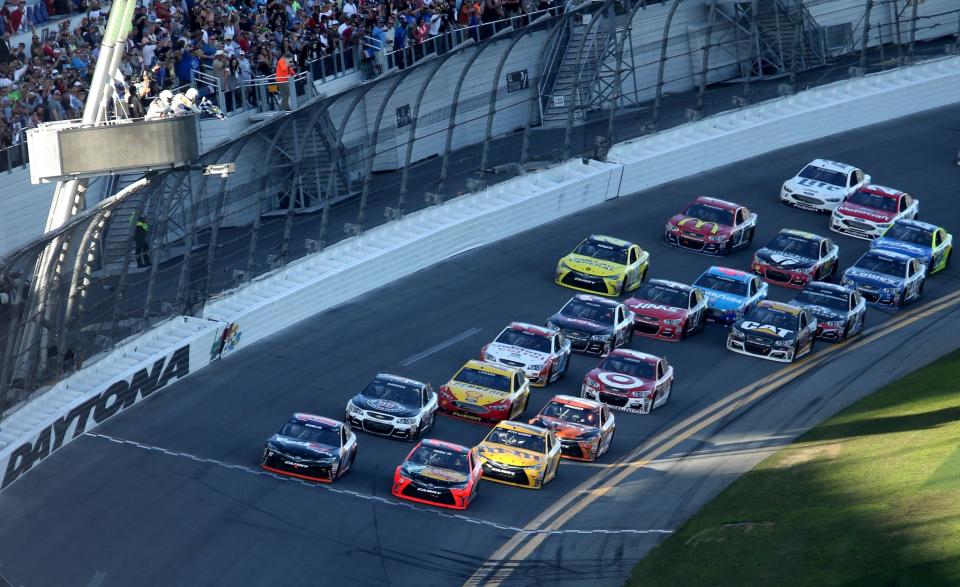Sometimes you have to slow down to win the Daytona 500
DAYTONA BEACH, Fla. — As he surged ahead of Martin Truex Jr. and Matt Kenseth faded away in his rear view mirror on the final lap of the 2016 Daytona 500, Denny Hamlin touched his brake pedal.
Yes, with seconds left in the race – and the Daytona 500 at stake – Hamlin made a conscious decision to slow his car down. He knew he had to give Truex a head start in the sprint to the finish. It was the only way he had a shot to win the race.
“It sounds counter-intuitive when you see the finish line and you’re hitting the brake, but I knew I needed to be behind him about 300 yards before the start-finish to be ahead of him by the time of the start-finish,” Hamlin told Yahoo Sports.
So Hamlin grazed the brake pedal enough to pull his front bumper right behind Truex’s right front tire.
“That was the most optimum place to be on his car,” Hamlin said.
The move worked out – barely – as Hamlin’s car surged forward at the last possible instant and beat Truex’s car to the line by 12 inches.

Hamlin began the final lap in fourth and made his way to the front thanks to a strong push by Kevin Harvick. But he’s fully aware that without the initial push from Harvick, or the lane change from Kenseth to attempt to block Hamlin or if any of his teammates ahead had made a move first, he wouldn’t have been in position to win the 500.
“You look back at that and I think ‘If this guy moves up just a hair’ — none of it happens unless the inside line stays exactly where they are,” Hamlin said. “Kenseth makes the move that he does and if I don’t make that move on the front straightaway to hit the brake it never happens.”
Hamlin’s dramatic victory explains the high-speed chess match that is the Daytona 500. Modern NASCAR restrictor plate racing – where cars run in large packs because horsepower and acceleration is restricted to keep speeds down – forces drivers to predict what their competitors will do and have an attack and counter move ready for every anticipated maneuver.
“Plate racing, I feel like you have to be one move ahead all the time and you have to have one in the bank that nobody has seen yet,” Brad Keselowski said. “In that regard you don’t know who has one in the bank and you never know who is learning and moving forward based on mistakes or lessons learned.”
The moves drivers execute now are a far cry from the nose-to-tail slingshot passes that made drivers like Richard Petty and Dale Earnhardt famous. The ability to catch another car from behind and rocket past has been replaced with the side-draft, where drivers can slow down their opponents and rocket past them by utilizing pockets of air formed between the cars.
And sometimes those moves are done blindly. While legend is that Earnhardt could see the air and the draft to pass his competitors, today’s Cup Series drivers have to feel the air to win.
“It is tricky because a lot of times when you’re on the inside you can’t see the car that you’re side drafting,” Hamlin said. “You have to almost feel them in a sense and so it’s very, very difficult.”
The increased importance of the side draft and the field’s use of the tactic also means that the days of a driver making a late-race charge to win at a plate track are pretty much over. Barring calamity, the driver that wins Sunday’s race will likely be near the front over the final 20 laps.
“These races, I don’t think people realize it as much, but track position is big at superspeedway racing,” Joey Logano said. “We’ve seen drivers be able to go from 10th to first in the last lap, yeah, that can happen, [but] it doesn’t happen often these days.”
It stands to reason Hamlin, Keselowski and Logano will be among those drivers at the front. They’ve become the masters in this game of high-speed side-drafting chess. Logano and Hamlin have won the last two Daytona 500s, while Keselowski won at both Daytona and Talladega a year ago.
“Think about this, that entire field is running wide open,” Hamlin said. “So how are there cars in the front? It’s the guys that manipulate that air the best are the ones that are up front. You have to plan your moves, plan when you get it and I think you have to be very intelligent when it comes to super speedway racing.”
But no one can predict the future. While drivers may have an idea of who may pull to the low side or go three-wide up high, they don’t know for sure until it happens. Whoever wins the 59th Daytona 500 will have made more than a few right moves. But he or she will have also benefited from plenty of circumstances out of their control, too.
“You have to try to see what’s going on a lap ahead all the time, and that’s really hard to put all of that together because to be able to do that you have to have great information from behind and what your spotter sees, and you have to have that communication really well, and then you have to see runs forming, and you have to know who you’re racing against and what type of moves they’re prone to making,” Logano said.
“You have to process all of that information before you make that split-second move when that opportunity comes up to make that big pass.”
– – – – – – –
Nick Bromberg is the editor of From The Marbles on Yahoo Sports. Have a tip? Email him at nickbromberg@yahoo.com or follow him on Twitter!

 Yahoo Sports
Yahoo Sports 

